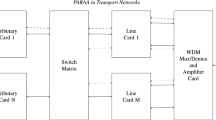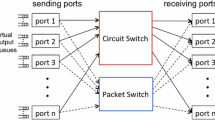Abstract
We investigate the impact of link and path restoration on the cost of telecommunication networks. The main observation is that the cost of an optimal network configuration is almost independent of the restoration concept if (i) the installation of network elements (ADMs, DXCs, or routers) and interface cards, (ii) link capacities, and (iii) working and restoration routings are simultaneously optimized.
We present a mixed-integer programming model which integrates all these decisions. Using a branch-and-cut algorithm (with column generation to deal with all admissible routing paths), we solve structurally different real-world based problem instances and show that the cost of optimal solutions is almost independent of the used restoration concept.
In addition, we optimize spare capacities based on predetermined shortest working paths with respect to different link weights. On our test instances, the additional cost of solutions obtained with this sequential approach, compared to simultaneous optimization of working and restoration routings, varies between 0 and 164%.
Similar content being viewed by others
References
Y. Xiong, L. Mason, Restoration strategies and spare capacity requirements in selfhealing ATM networks, IEEE infocom’97, pp. 353–360, 1997.
R. Iraschko, M. MacGregor, and W. D. Grover, Optimal capacity placement for path restoration in STM or ATM mesh survivable networks, IEEE/ACM Transactions on Networking, Vol. 6, No. 3, pp. 325–336, 1998.
J. L. Kennington, V. S. S. Nair, and G. Spride, Optimal spare capacity assignment for path restorable mesh networks: Cuts, decomposition, and an empirical analysis, Technical Report 98-CSE-1, Department of Computer Science and Engineering, Southern methodist University, Dallas, 1998.
F. Poppe and P. Demeester, Economic allocation of spare capacity in mesh-restorable networks: Models and algorithms, 6th International Conference on Telecommunications Systems, Modelling and Analysis, Nashville, pp. 77–86, March 1998.
J. Doucette and W. D. Grover, Comparision of mesh protection and restoration schemes and the dependency on graph connectivity. 3rd International Workshop on Design of Reliable Communication networks (DRCN 2001), pp. 121–128, October 2001.
M. Iri, On and extension of the maximum-flow minimum-cut theorem to multicommodity flows, Journal of the Operations Research Society of Japan, Vol. 13, No. 3, pp. 129–135, 1971.
K. Murakami, Survivable network management for high-speed ATM networks, PhD thesis, Carnegie-Mellon University, 1995.
B. Van Caenegem, N. Wauters, and P. Demeester, Spare capacity assignment for different restoration strategies in mesh survivable networks, IEEE International Conference on Communication 1997, pp. 288–292, 1997.
DISCNET, Network planning and configuration engine. Atesio GmbH, http://www.atesio.de, 2000–2004.
G. Dahl and M. Stoer, A polyhedral approach to multicommodity survivable network design, Numerische Mathematik, Vol. 68, No. 1, pp. 149–167, 1994.
J. Doucett and W. D. Grover, Increasing the efficiency of span-restorable mesh networks on low-connectivity graphs, 3rd International workshop on Design of Reliable Communication Networks (DRCN 2001), Budapest, pp. 99–106, 2001.
M. Minoux, Optimum synthesis of a network with non-simultaneous MCF requirements, Studies on Graphs and Discrete Programming, P. Hansen (ed.), pp. 269–277. North Holland Publishing Company, 1981.
R. Wessäly, Dimensioning Survivable Capacitated Networks, PhD thesis, TU Berlin, 2000.
J. Benders, Partioning procedures for solving mixed-variables programming problems, Numerische Mathematik, Vol. 4, No. 1, pp. 238–252, 1962.
M. Padberg and G. Rinaldi, A branch and cut algorithm for the resolution of large-scale symmetric travelling salesman problems, SIAM Review, No. 33, pp. 60–100, 1991.
L. A. Wolsey, Valid inequality for 0/1 knapsacks and MIPs with generalised upper bound constraints, Discrete Applied Mathematics, No. 29, pp. 251–261, 1990.
S. Orlowski, Local and global restoration of node and link failures in telecommunication networks, Diploma thesis, TU Berlin, 2003.
ILOG CPLEX 8.0, Retrieved from http://www.ilog.com/products/cplex.
S. Orlowski and R. Wessäly, The effect of hop limits on optimal cost in survivable network design, Telecommunications Network Design and Economics and Management, G. Anandalingam and S. Raghavan (eds.), 2004, to appear. Preprint version available at ftp://ftp.zib.de/pub/zip-publications/reports/ZR-04-23.pdf.
Author information
Authors and Affiliations
Corresponding author
Additional information
Sebastian Orlowski has studied mathematics at the Technical University of Berlin, Germany. Since June 2003, he has been a research assistant at the Zuse Institute Berlin (ZIB), where he works on the design of cost-efficient telecommunication networks under survivability constraints. The current focus of his research within the DFG Research Center MATHEON is multi-layer network planning.
Roland Wessäly graduated from the Technical University of Berlin with a Master’s Degree in Computer Science. Since 1994 he has been a member of the optimization group at the Zuse Institute Berlin (ZIB). He developed optimization methods for the design of survivable capacitated telecommunication networks as part of his PhD Thesis in Mathematics (finished in April 2000). In 2001 he received the Vodafone Innovations award for his scientific work on network design. Since 2000 he has been managing director of the ZIB spin-off atesio GmbH, a company specialized on planning and optimization algorithms for telecommunication network operators.
Rights and permissions
About this article
Cite this article
Orlowski, S., Wessäly, R. Comparing Restoration Concepts Using Optimal Network Configurations with Integrated Hardware and Routing Decisions. J Netw Syst Manage 13, 99–118 (2005). https://doi.org/10.1007/s10922-005-1864-3
Issue Date:
DOI: https://doi.org/10.1007/s10922-005-1864-3




